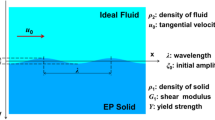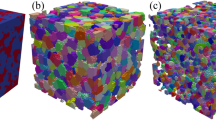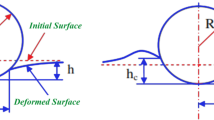Abstract
THE process of indentation of a metal surface by a hard spherical indenter has been examined in considerable detail by Tabor1 and others. If the indenter makes contact with the surface over a circular area of radius a under the action of a load W, the mean contact pressure pm=W/πa2. Tabor showed that plastic yielding begins beneath the surface of the metal when pm reaches the value 1.1 Y (where Y=yield stress of the metal in simple tension). As the load is increased and a marked plastic indentation develops, the mean pressure approaches a value which is independent of the load given by:  where c has a value of approximately 3. This is the state of affairs in a Brinell hardness test.
where c has a value of approximately 3. This is the state of affairs in a Brinell hardness test.
This is a preview of subscription content, access via your institution
Access options
Subscribe to this journal
Receive 51 print issues and online access
$199.00 per year
only $3.90 per issue
Buy this article
- Purchase on SpringerLink
- Instant access to full article PDF
Prices may be subject to local taxes which are calculated during checkout
Similar content being viewed by others
References
Tabor, D., Hardness of Metals (Oxford Univ. Press, 1951); Proc. Roy. Soc., A, 192, 247 (1948).
Tyler, J. C., Burton, R. A., and Ku, P. M., paper presented at the A.S.L.E. Annual Meeting, New York, April 1963.
Author information
Authors and Affiliations
Rights and permissions
About this article
Cite this article
JOHNSON, K. Reversed Plastic Flow during the Unloading of a Spherical Indenter. Nature 199, 1282 (1963). https://doi.org/10.1038/1991282a0
Issue date:
DOI: https://doi.org/10.1038/1991282a0
This article is cited by
-
The indentation of hard metals: the role of residual stresses
Journal of Materials Science (1977)



